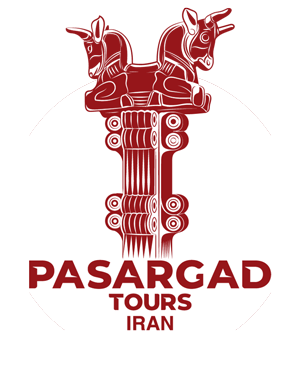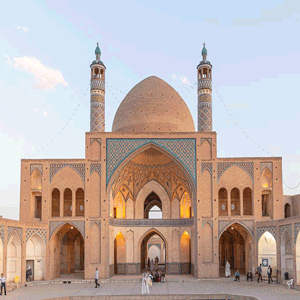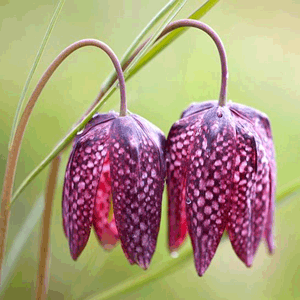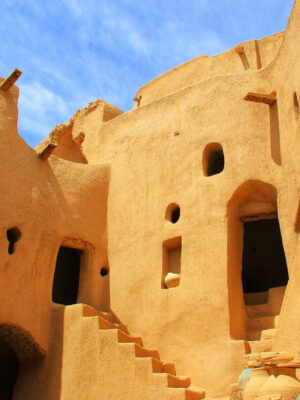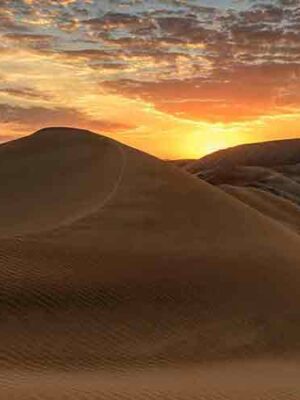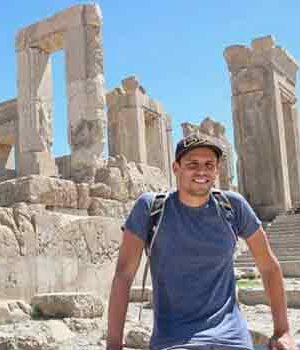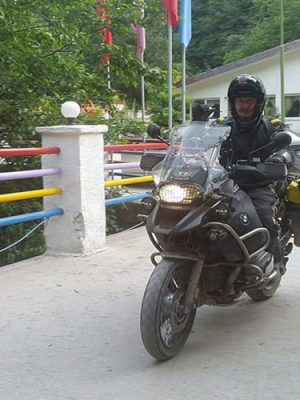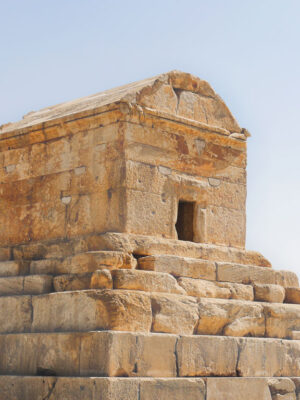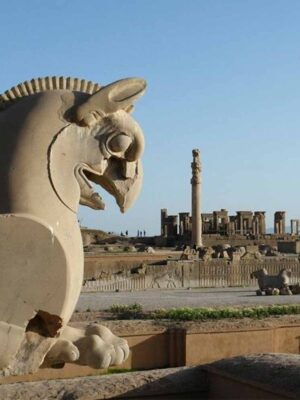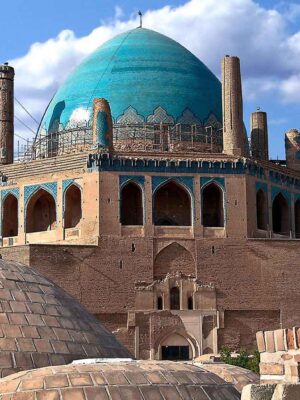Nowruz
Marking the very beginning of the spring in the northern hemisphere, Nowruz is a holiday for celebrating the new year in the Iranian calendar. Nowruz translates crudely to “new day”, but the meaning is somewhat more poetic; It signifies a new beginning rather than a single day. It begins with the moment at which the Sun crosses the celestial equator and equalizes night and day. Nevertheless, the rituals of this holiday which lasts for 13 days bear no celestial significance; They are celebrations for rejuvenation of life and nature on this very earth.
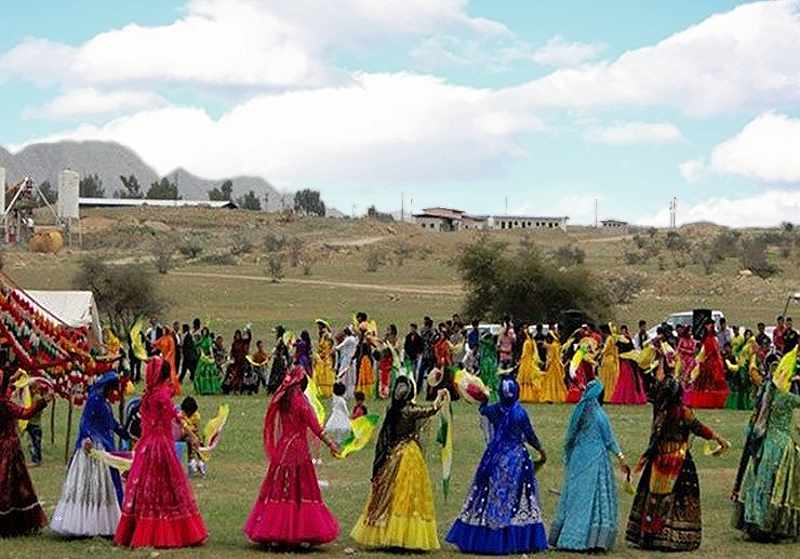
Nowruz celebration at a rural area in the western region of Iran
Iranians have been celebrating this day for more than 3,000 years. Its roots are as a feast day in Zoroastrianism, which regarded the arrival of spring as a triumph of light over the darkness of the winter. The cheerful disposition that follows such a triumph still sweeps over the entire nation. Much like the merry mood of Christmas in western countries, Iranians experience a joyful social thrill that enchants every aspect of their life. As if enchanted by some spell, the people become more cheerful.
Being a nation of several ethnic communities, Nowruz is celebrated with a particular flavor in each part of the country. Each of them has its very own style of festive gatherings, songs, and dances. Yet, Iranians cheerfully embrace these differences. And while the 13-day holidays of Nowruz provide a chance for a lengthy vacation, many Iranians travel to different regions of the country to partake in a rather exotic form of celebration.
Who Celebrates Nowruz?
Even though the festival is originally Iranian, over 300 million people touched by Iranian civilization throughout history celebrate this day. Counties around the Black Sea basin, the Balkans, the South Caucasus, and Asia have national holidays celebrating this day. Nowruz pronunciation varies almost in each of these communities; Nevertheless, despite their ethnic diversity or the way they pronounce it, this day has a special place in their hearts.
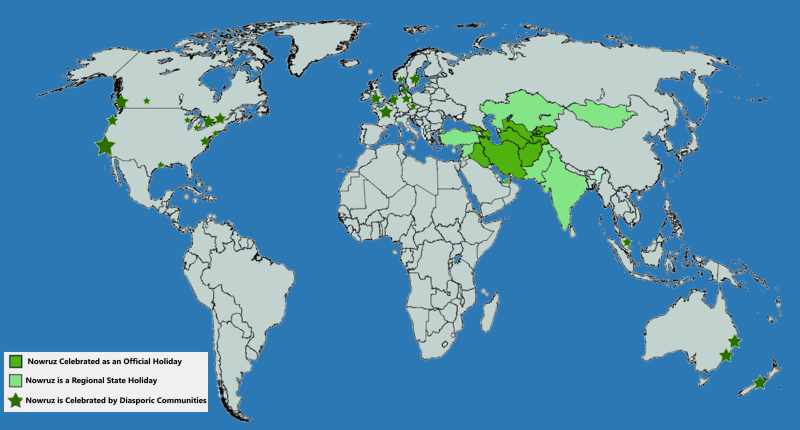
Countries and Regions Celebrating Nowruz
More recently, Iranian communities in western countries publicly celebrate the Iranian new year. Furthermore, In 2016, Nowruz was celebrated in the UN headquarters as UNESCO, the cultural arm of the United Nations, listed the “International Nowruz Day” on its Representative List of the Intangible Cultural Heritage of Humanity.
How is it Celebrated?
While the arrival eve of the Iranian new year is precisely measurable, the rituals of the celebration begin days in advance and are in no way precise. It constitutes a series of practices in preparation for the new year as well as rites and costumes for the Nowruz eve and ensuing days. These rites vary in different regions and are altered based on the religious beliefs and local environment of each ethnicity. In some regions, the celebration even includes public gatherings and traditional dancing. While merry-making is a constant amongst all those who celebrate Nowruz the form and extent of such activities vary. However, they more or less adhere to the pattern described in the followings:
Khane Tekani
For Iranian people, it commonly begins with a cleansing ritual of their home; A practice called “Khane Tekani” (lit. shaking the house) meaning a thorough cleaning and dusting process. The common belief is that the state of all things in next year will be the continuation of how they have been at the end of this year. Therefore, “Khane Tekani” is a ritual for having a clean and healthy household for the coming year.
Remembrance of The Dead
It is also customary to visit the graves of deceased relatives, especially amongst religious people. They observe this pledge of remembrance usually on the last Thursday of the year. Iranians more closely follow this costume for those who lost their lives in that year, to honor their memories. The ritual usually includes cleansing the gravestones, bringing flowers, and saying prayers for the dead.
Haft-Sin
A day before Nowruz, each family sets a special table called “Haft-Sin” (lit. The Seven “S”). The family gathers around this table wearing new clothes and awaits the exact moment of the vernal equinox to celebrate the New Year. The contemporary explanation of Haft-sin is simply seven things beginning with the letter sin (س) are:
- Sabze (Persian: سبزه) – wheat, barley, mung bean, or lentil sprouts grown in a dish.
- Samanu (Persian: سمنو) – a sweet pudding made from wheat germ
- Persian olive (Persian: سنجد, romanized: senjed)
- Vinegar (Persian: سرکه, romanized: serke)
- Apple (Persian: سیب, romanized: sib)
- Garlic (Persian: سیر, romanized: sir)
- Sumac (Persian: سماق, romanized: somāq)
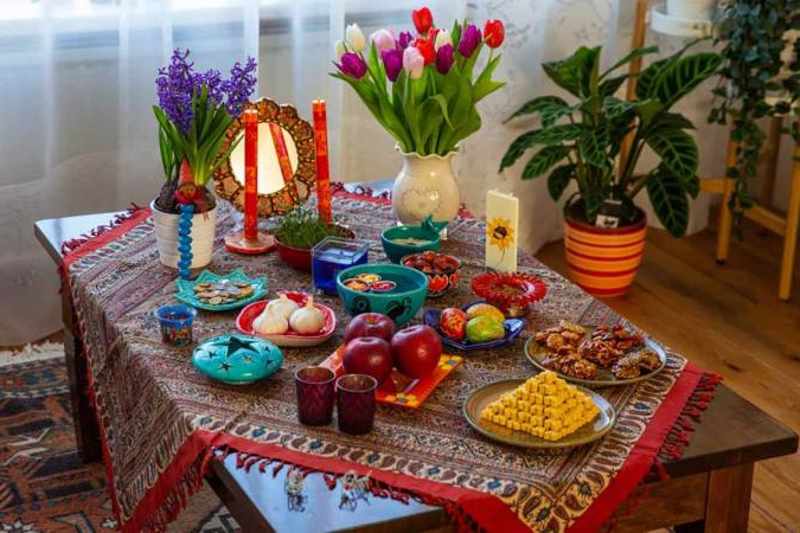
Haft-Sin Table
The Haft-sin table usually includes a mirror, candles, painted eggs, a bowl of water, goldfish, coins, hyacinth, and traditional confectioneries. Most people place a “book of wisdom” such as the Quran, Bible, Avesta, the Šāhnāme of Ferdowsi, or the divān of Hafez on the table. Selecting this book reflects the religious and even in times the political orientation of the family. Similarly, the choice of containers and decoration reflects the artistic taste and economic status. This contemporary composition of Haft-Sin is relatively new and believed to have been popularized over the past 100 years. However, the roots of this tradition go way back back to seven Ameshasepantas as mentioned in the Zend-Avesta, the holy scripture of Zaratostians.
Amu Nowruz and Hajji Firuz
In Iran, Amu Nowruz and Haji Firuz are traditional personas of the New Year festival who perform publicly in the streets to celebrate the New Year. Amu Nowruz can be regarded as an Iranian rendition of Santa Claus who brings the children gifts. The role of Amu Nowruz is more and more lessened in the past decades and is seldom performed these days. However, the role of his sidekick Haji Firuz became a national success. Haji Firuz is a satirical character with his face and hands covered in soot, wearing bright red clothes. He dances through the streets while singing with a bad voice and playing the tambourine to cheer people up.
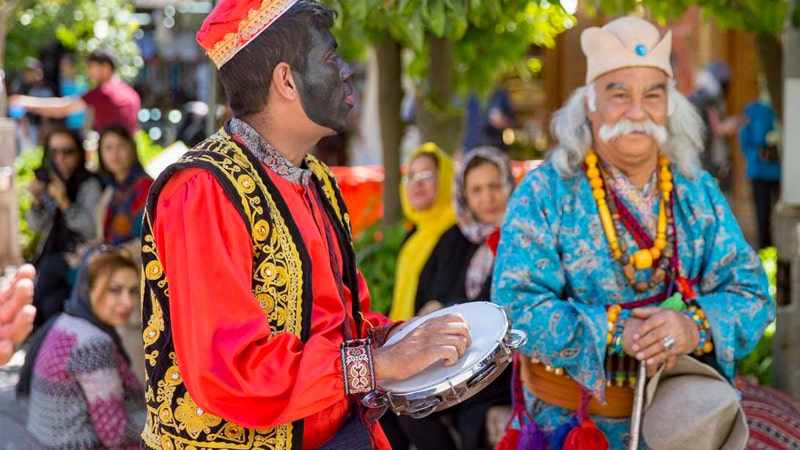
Amu Nowruz and Hajji Firuz Performing in Public
Sizdah Be-Dar
The celebration lasts for 12 days during which families and friends visit each other’s houses and congratulate the arrival of the new year (Saying, “Nowruz Mubarak”). On the 13th and final day of the Nowruz celebration, however, people picnic in public or private parks or natural sceneries. The common belief is by doing so, they can break from the bad luck attributed to number 13. Contrary to what the commoners hold true, the root and rituals for celebrating this day reside in Zoroastrianism and honoring Tishtar, the god of rain.
While being the concluding ceremony of Nowruz, Sizdah Be-Dar and its traditional feats are almost as important as the first day of Nowruz. Accordingly, there are special foods, particular acts, and ceremonies for this day. Therefore, we have dedicated an entire article to this day where you can find more information about this special day, its history, and the related costumes.
Nowruz Food and Gastronomy
Perhaps the most iconic food cooked for Nowruz is Samanu. This food is prepared using wheat germ and some ethnicities have certain rituals during the process. Women and girls in different parts of Iran, Afghanistan, Tajikistan, Turkmenistan, and Uzbekistan cook Samanu in groups and sometimes during the night, and when cooking it, they sing memorable songs. However, the contemporary population, especially in large cities no longer adhere to this ceremony and simply buy this food from groceries.
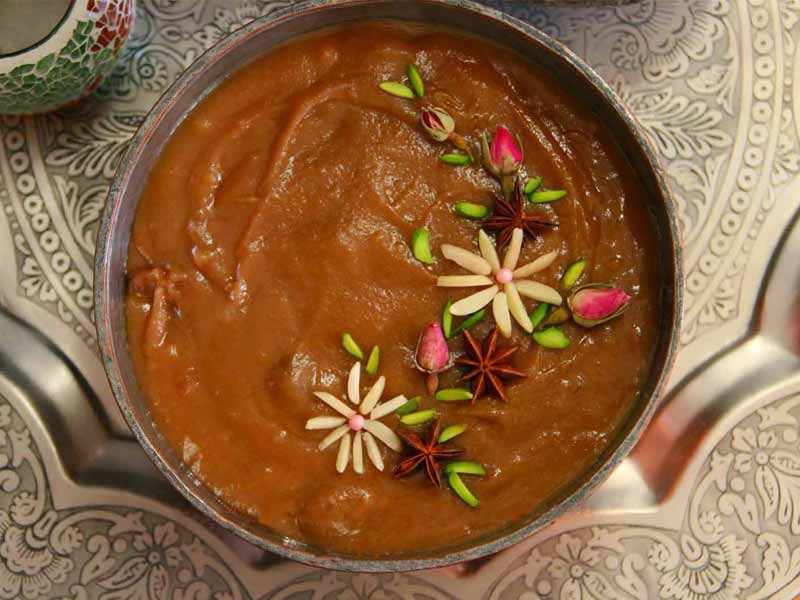
A Bowl of Samanu Decorated with Nuts and Rosebuds
There are other dishes, however, that people tend to cook more commonly for Nowruz depending on the locality and regional costumes. For example, in Iran serving Sabzi polo (rice and green herbs) with fish the night before Nowruz is as serious a matter as if it were a religious decree. The same is true for Reshteh Polo (rice and thin noodles) with chicken for the first lunch of Nowruz.
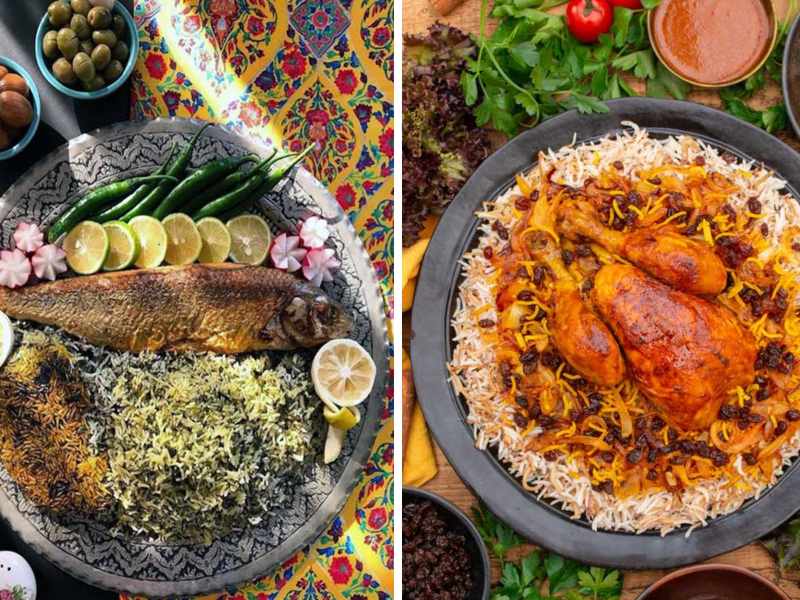
The Traditional Foods of Nowruz in Iran – Sabzi Polo with fish and Reshteh Polo with Chicken
In Afghanistan, a combination of dried seeds and fruits served with syrup called Haft-Meiwa has the same importance.
Nowruz and Religion
Even though people with different religions and faith celebrate Nowruz, it is mostly celebrated in certain Muslim countries. To know what is Nowruz in Islam, one must be familiar with the sectarian differences of Shia and Sunni. Shia Islam, which had a close relationship with Iranian people throughout its history, celebrates Nowruz and considers it as a holy day. Some Shia scholars even consider Nowruz as the day of the covenant. A day that God made the pact with humans to worship him and obey his prophets. On the other hand, Sunnis regard Nowruz as a paganistic celebration and some even consider it to be Haram.
Places to Visit in Iran During Nowruz Holidays
Since the entire nation is in its best mood during the Nowruz holidays, It is one of the best seasons to visit any part of the country or any attraction site. The festivities during this holiday provide you with a chance to participate in local celebrations and special events and venues. The pleasant spring weather would also contribute to the delights of your visit. However, depending on what your interests are, the best place for your visit might vary. That is why we encourage you to contact us at Pasargad Tours for more information about our tours and selecting the best touring options in accordance with your appeals and interests.
Nowruz
Marking the very beginning of the spring in the northern hemisphere, Nowruz is a holiday for celebrating the new year in the Iranian calendar. Nowruz translates crudely to “new day”, but the meaning is somewhat more poetic; It signifies a new beginning rather than a single day. It begins with the moment at which the Sun crosses the celestial equator and equalizes night and day. Nevertheless, the rituals of this holiday which lasts for 13 days bear no celestial significance; They are celebrations for rejuvenation of life and nature on this very earth.

Nowruz celebration at a rural area in the western region of Iran
Iranians have been celebrating this day for more than 3,000 years. Its roots are as a feast day in Zoroastrianism, which regarded the arrival of spring as a triumph of light over the darkness of the winter. The cheerful disposition that follows such a triumph still sweeps over the entire nation. Much like the merry mood of Christmas in western countries, Iranians experience a joyful social thrill that enchants every aspect of their life. As if enchanted by some spell, the people become more cheerful.
Being a nation of several ethnic communities, Nowruz is celebrated with a particular flavor in each part of the country. Each of them has its very own style of festive gatherings, songs, and dances. Yet, Iranians cheerfully embrace these differences. And while the 13-day holidays of Nowruz provide a chance for a lengthy vacation, many Iranians travel to different regions of the country to partake in a rather exotic form of celebration.
Who Celebrates Nowruz?
Even though the festival is originally Iranian, over 300 million people touched by Iranian civilization throughout history celebrate this day. Counties around the Black Sea basin, the Balkans, the South Caucasus, and Asia have national holidays celebrating this day. Nowruz pronunciation varies almost in each of these communities; Nevertheless, despite their ethnic diversity or the way they pronounce it, this day has a special place in their hearts.

Countries and Regions Celebrating Nowruz
More recently, Iranian communities in western countries publicly celebrate the Iranian new year. Furthermore, In 2016, Nowruz was celebrated in the UN headquarters as UNESCO, the cultural arm of the United Nations, listed the “International Nowruz Day” on its Representative List of the Intangible Cultural Heritage of Humanity.
How is it Celebrated?
While the arrival eve of the Iranian new year is precisely measurable, the rituals of the celebration begin days in advance and are in no way precise. It constitutes a series of practices in preparation for the new year as well as rites and costumes for the Nowruz eve and ensuing days. These rites vary in different regions and are altered based on the religious beliefs and local environment of each ethnicity. In some regions, the celebration even includes public gatherings and traditional dancing. While merry-making is a constant amongst all those who celebrate Nowruz the form and extent of such activities vary. However, they more or less adhere to the pattern described in the followings:
Khane Tekani
For Iranian people, it commonly begins with a cleansing ritual of their home; A practice called “Khane Tekani” (lit. shaking the house) meaning a thorough cleaning and dusting process. The common belief is that the state of all things in next year will be the continuation of how they have been at the end of this year. Therefore, “Khane Tekani” is a ritual for having a clean and healthy household for the coming year.
Remembrance of The Dead
It is also customary to visit the graves of deceased relatives, especially amongst religious people. They observe this pledge of remembrance usually on the last Thursday of the year. Iranians more closely follow this costume for those who lost their lives in that year, to honor their memories. The ritual usually includes cleansing the gravestones, bringing flowers, and saying prayers for the dead.
Haft-Sin
A day before Nowruz, each family sets a special table called “Haft-Sin” (lit. The Seven “S”). The family gathers around this table wearing new clothes and awaits the exact moment of the vernal equinox to celebrate the New Year. The contemporary explanation of Haft-sin is simply seven things beginning with the letter sin (س) are:
- Sabze (Persian: سبزه) – wheat, barley, mung bean, or lentil sprouts grown in a dish.
- Samanu (Persian: سمنو) – a sweet pudding made from wheat germ
- Persian olive (Persian: سنجد, romanized: senjed)
- Vinegar (Persian: سرکه, romanized: serke)
- Apple (Persian: سیب, romanized: sib)
- Garlic (Persian: سیر, romanized: sir)
- Sumac (Persian: سماق, romanized: somāq)

Haft-Sin Table
The Haft-sin table usually includes a mirror, candles, painted eggs, a bowl of water, goldfish, coins, hyacinth, and traditional confectioneries. Most people place a “book of wisdom” such as the Quran, Bible, Avesta, the Šāhnāme of Ferdowsi, or the divān of Hafez on the table. Selecting this book reflects the religious and even in times the political orientation of the family. Similarly, the choice of containers and decoration reflects the artistic taste and economic status. This contemporary composition of Haft-Sin is relatively new and believed to have been popularized over the past 100 years. However, the roots of this tradition go way back back to seven Ameshasepantas as mentioned in the Zend-Avesta, the holy scripture of Zaratostians.
Amu Nowruz and Hajji Firuz
In Iran, Amu Nowruz and Haji Firuz are traditional personas of the New Year festival who perform publicly in the streets to celebrate the New Year. Amu Nowruz can be regarded as an Iranian rendition of Santa Claus who brings the children gifts. The role of Amu Nowruz is more and more lessened in the past decades and is seldom performed these days. However, the role of his sidekick Haji Firuz became a national success. Haji Firuz is a satirical character with his face and hands covered in soot, wearing bright red clothes. He dances through the streets while singing with a bad voice and playing the tambourine to cheer people up.

Amu Nowruz and Hajji Firuz Performing in Public
Sizdah Be-Dar
The celebration lasts for 12 days during which families and friends visit each other’s houses and congratulate the arrival of the new year (Saying, “Nowruz Mubarak”). On the 13th and final day of the Nowruz celebration, however, people picnic in public or private parks or natural sceneries. The common belief is by doing so, they can break from the bad luck attributed to number 13. Contrary to what the commoners hold true, the root and rituals for celebrating this day reside in Zoroastrianism and honoring Tishtar, the god of rain.
While being the concluding ceremony of Nowruz, Sizdah Be-Dar and its traditional feats are almost as important as the first day of Nowruz. Accordingly, there are special foods, particular acts, and ceremonies for this day. Therefore, we have dedicated an entire article to this day where you can find more information about this special day, its history, and the related costumes.
Nowruz Food and Gastronomy
Perhaps the most iconic food cooked for Nowruz is Samanu. This food is prepared using wheat germ and some ethnicities have certain rituals during the process. Women and girls in different parts of Iran, Afghanistan, Tajikistan, Turkmenistan, and Uzbekistan cook Samanu in groups and sometimes during the night, and when cooking it, they sing memorable songs. However, the contemporary population, especially in large cities no longer adhere to this ceremony and simply buy this food from groceries.

A Bowl of Samanu Decorated with Nuts and Rosebuds
There are other dishes, however, that people tend to cook more commonly for Nowruz depending on the locality and regional costumes. For example, in Iran serving Sabzi polo (rice and green herbs) with fish the night before Nowruz is as serious a matter as if it were a religious decree. The same is true for Reshteh Polo (rice and thin noodles) with chicken for the first lunch of Nowruz.

The Traditional Foods of Nowruz in Iran – Sabzi Polo with fish and Reshteh Polo with Chicken
In Afghanistan, a combination of dried seeds and fruits served with syrup called Haft-Meiwa has the same importance.
Nowruz and Religion
Even though people with different religions and faith celebrate Nowruz, it is mostly celebrated in certain Muslim countries. To know what is Nowruz in Islam, one must be familiar with the sectarian differences of Shia and Sunni. Shia Islam, which had a close relationship with Iranian people throughout its history, celebrates Nowruz and considers it as a holy day. Some Shia scholars even consider Nowruz as the day of the covenant. A day that God made the pact with humans to worship him and obey his prophets. On the other hand, Sunnis regard Nowruz as a paganistic celebration and some even consider it to be Haram.
Places to Visit in Iran During Nowruz Holidays
Since the entire nation is in its best mood during the Nowruz holidays, It is one of the best seasons to visit any part of the country or any attraction site. The festivities during this holiday provide you with a chance to participate in local celebrations and special events and venues. The pleasant spring weather would also contribute to the delights of your visit. However, depending on what your interests are, the best place for your visit might vary. That is why we encourage you to contact us at Pasargad Tours for more information about our tours and selecting the best touring options in accordance with your appeals and interests.




